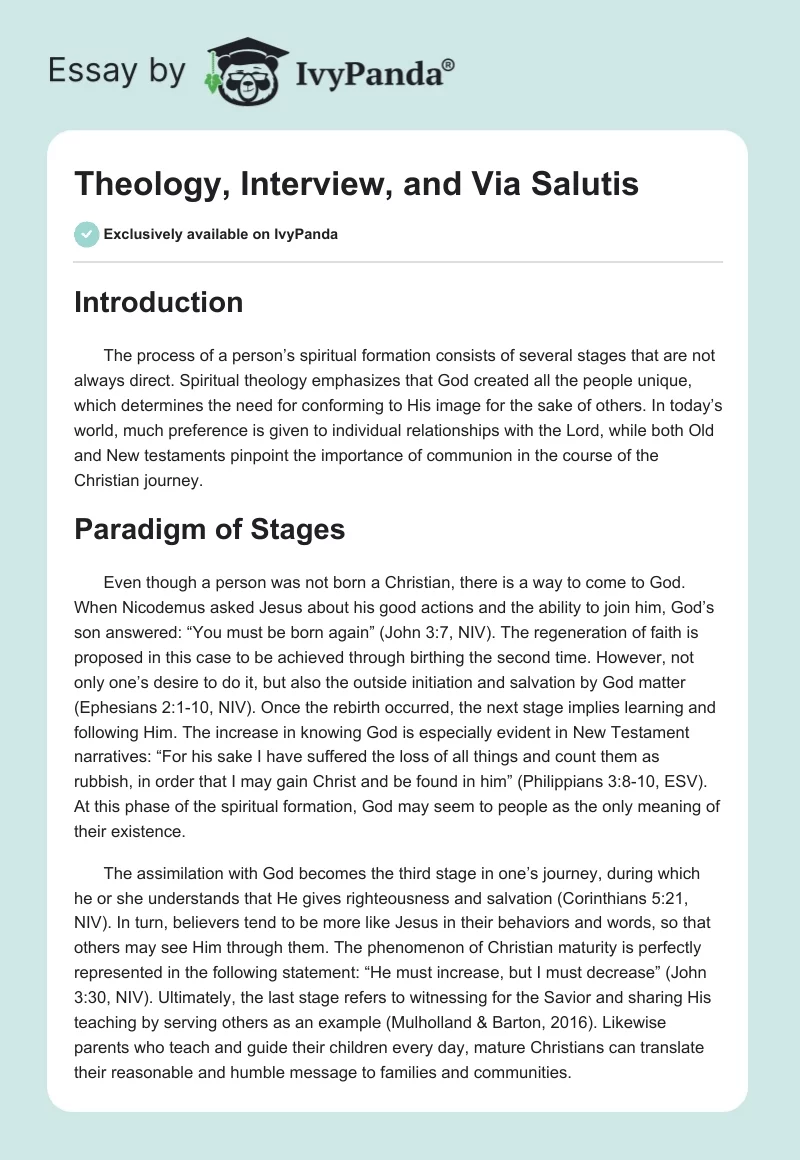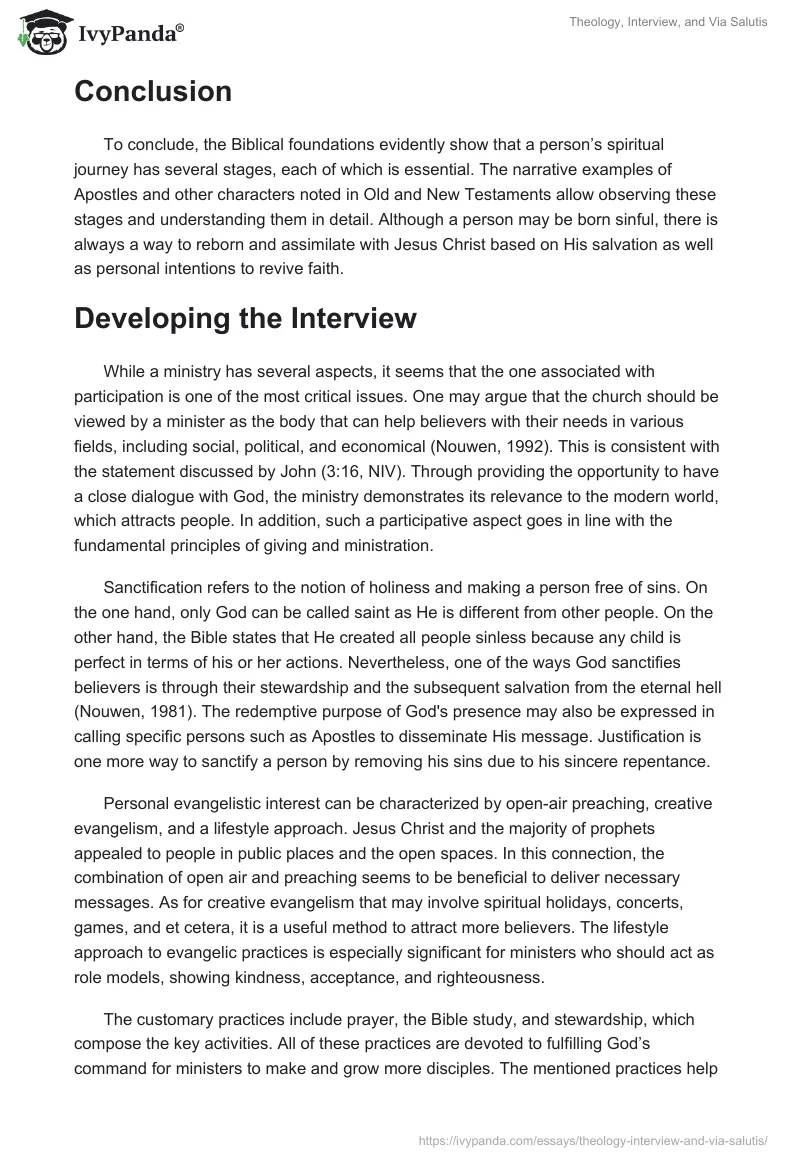Introduction
The process of a person’s spiritual formation consists of several stages that are not always direct. Spiritual theology emphasizes that God created all the people unique, which determines the need for conforming to His image for the sake of others. In today’s world, much preference is given to individual relationships with the Lord, while both Old and New testaments pinpoint the importance of communion in the course of the Christian journey.
Paradigm of Stages
Even though a person was not born a Christian, there is a way to come to God. When Nicodemus asked Jesus about his good actions and the ability to join him, God’s son answered: “You must be born again” (John 3:7, NIV). The regeneration of faith is proposed in this case to be achieved through birthing the second time. However, not only one’s desire to do it, but also the outside initiation and salvation by God matter (Ephesians 2:1-10, NIV). Once the rebirth occurred, the next stage implies learning and following Him. The increase in knowing God is especially evident in New Testament narratives: “For his sake I have suffered the loss of all things and count them as rubbish, in order that I may gain Christ and be found in him” (Philippians 3:8-10, ESV). At this phase of the spiritual formation, God may seem to people as the only meaning of their existence.
The assimilation with God becomes the third stage in one’s journey, during which he or she understands that He gives righteousness and salvation (Corinthians 5:21, NIV). In turn, believers tend to be more like Jesus in their behaviors and words, so that others may see Him through them. The phenomenon of Christian maturity is perfectly represented in the following statement: “He must increase, but I must decrease” (John 3:30, NIV). Ultimately, the last stage refers to witnessing for the Savior and sharing His teaching by serving others as an example (Mulholland & Barton, 2016). Likewise parents who teach and guide their children every day, mature Christians can translate their reasonable and humble message to families and communities.
Conclusion
To conclude, the Biblical foundations evidently show that a person’s spiritual journey has several stages, each of which is essential. The narrative examples of Apostles and other characters noted in Old and New Testaments allow observing these stages and understanding them in detail. Although a person may be born sinful, there is always a way to reborn and assimilate with Jesus Christ based on His salvation as well as personal intentions to revive faith.
Developing the Interview
While a ministry has several aspects, it seems that the one associated with participation is one of the most critical issues. One may argue that the church should be viewed by a minister as the body that can help believers with their needs in various fields, including social, political, and economical (Nouwen, 1992). This is consistent with the statement discussed by John (3:16, NIV). Through providing the opportunity to have a close dialogue with God, the ministry demonstrates its relevance to the modern world, which attracts people. In addition, such a participative aspect goes in line with the fundamental principles of giving and ministration.
Sanctification refers to the notion of holiness and making a person free of sins. On the one hand, only God can be called saint as He is different from other people. On the other hand, the Bible states that He created all people sinless because any child is perfect in terms of his or her actions. Nevertheless, one of the ways God sanctifies believers is through their stewardship and the subsequent salvation from the eternal hell (Nouwen, 1981). The redemptive purpose of God’s presence may also be expressed in calling specific persons such as Apostles to disseminate His message. Justification is one more way to sanctify a person by removing his sins due to his sincere repentance.
Personal evangelistic interest can be characterized by open-air preaching, creative evangelism, and a lifestyle approach. Jesus Christ and the majority of prophets appealed to people in public places and the open spaces. In this connection, the combination of open air and preaching seems to be beneficial to deliver necessary messages. As for creative evangelism that may involve spiritual holidays, concerts, games, and et cetera, it is a useful method to attract more believers. The lifestyle approach to evangelic practices is especially significant for ministers who should act as role models, showing kindness, acceptance, and righteousness.
The customary practices include prayer, the Bible study, and stewardship, which compose the key activities. All of these practices are devoted to fulfilling God’s command for ministers to make and grow more disciples. The mentioned practices help in conforming to His image and ensuring that the congregation also follows this journey. Fasting and meditation are two more specific practices that can be used for an in-depth understanding of Christianity with its history, current tendencies, problems, and self-perception in its context.
A successful pastor is an integral part of an effective church, which are closely intertwined. The pastoral ministry may encounter such challenges as consumerism, mistrust, and competition, and a good pastor should combat them by applying the roles of a shepherd and teacher. He or she should give inspiration to colleagues and the congregation to evoke trust of believers and win their loyalty. In addition, all the testaments should be accomplished periodically, such as caring for those in need, reaching the lost, and preaching sound doctrine (James 1:27; Timothy 4:6; NIV). The constant aspiration of a pastor to knowledge and practice make his or her church successful.
Via Salutis Chart

The Way of Salvation is a complex concept that can vary depending on one’s experience and faith traditions. In a Pentecostal Ministry, the recognition of the exclusive authority of the Holy Scriptures and God are prioritized. According to Pentecost conviction, the Lord does not need any material, visible forms of transmission of His grace, but, at the same time, they the ceremonial actions corresponding to the events described in the New Testament are preserved. It seems appropriate to focus on Wesley’s Developmental Model of Salvation as the foundation for developing an individual Via Salutis.
The first stage that is often faced by those who not yet believe is spiritual death. In the modern context, people tend to be overwhelmed by their jobs, families, and other tasks, having no time to consider the role of religion in their life (Nouwen, 1981). They may identify themselves as atheists or Christians, but they are full of temptation, desperation, and other feelings that prevent them from joining the church. At this stage, individuals have no responsibility, and God cannot give them His grace. When the lives of these people become too complicated, or a triggering event happens, they are likely to move to the next stage.
Sin awareness is the second stage on the way to salvation, which is marked by one’s comprehension of his or her bad deeds. A person starts to consider the link with God, but he or she is not sure that He will help them and whether they deserve it or not. Accordingly, they do not feel love or trust to the Lord, the ministry, and related issues. It is the responsibility of a potential believer to convince herself or himself in the righteousness of a spiritual life. It goes without saying that this is an extremely difficult task, but such small steps as the decision to visit the local church and have a face-to-face conversation with a priest can be helpful to begin a new stage. In turn, God’s calling becomes more apparent, which also contributes to one’s proceeding with personal fears and doubts.
The stage of conversion refers to both who passed the previous stages and those were born Christians. Jesus’ appearances to His disciples prove that everyone has the opportunity to come to God: “Jesus is the Messiah, the Son of God, and that by believing you may have life in his name” (John 20:31, NIV). People who addressed doubts tend to formulate their questions to priests and develop childlike trust to teachings provided by the ministry. Their negative emotions – jealousy, anger, impatience, aggression, and selfishness – are likely to reduce at this stage. As for those who regarded themselves as Christians since their birth, their lives seem to be inconsistent with their perceived preaching (Nouwen, 1981). For example, they may celebrate Easter and Christmas as religious events, but the rest of their lifestyles do not fit Christian principles. This stage can be the most important milestone in their spiritual formation since their responsibility lies in converting from occasional joy to continuous journey to God.
Once a person turned to a believer and started practicing Christian values and guidelines, one may conclude that he or she entered the stage that is titled as Life. The connection with the sacred becomes so strong that they circumvent temptations and practice going to God for advice (Mulholland & Barton, 2016). Love to the Lord and other people around is a characteristic sign of this stage, which encourages them to strengthen their faith and seek for more understanding from their teachers and other members of the congregation. God accomplishes the task of motivation by helping believers to address occurring difficulties and providing insights into the ways to overcome them. By reading the Holy Scripture and communicating with priests, people seem to become more devoted, sincere, open, and confident in their new lifestyles. Even though some problems and conflicts may appear, they can no longer prevent people from the established connection with Him. When a person masters his spiritual and personality skills, it is stimulated to share with others to step to the next stage.
The stage of Perfecting implies that a believer strives to become better by sharing his or her knowledge and assisting others in achieving the intimacy with God. The Bible states that “faith comes from hearing the message, and the message is heard through the word about Christ” (Romans 10:17, NIV). The Lord taught His disciples not only by word but also by all means by deeds, which is another essential aspect of the tradition of the Church. The Savior was followed by His disciples, for example, Apostle Paul approves of those who keep the narratives and orders that they move away from those who act without reason, not according to the tradition of the Apostles. Moral and mature Christians are always encouraged to disseminate their faith and contribute to the increase in the number of Pentecostal church followers.
Ultimately, the last stage is related to Heaven as the expression of afterlife. Death is a great mystery, it is the only definite fact of the future, which remains one of the most uncertain phenomena. The church consists of earthly and heavenly inhabitant, where the former carries out its mission under the grace-filled protection of celestials led by Jesus Christ – the true God. In its turn, the earthly Church also provides help and support for the heaven by preparing believers to avoid the eternal and peacefully transfer to the other life. Perhaps, this stage is the most important part of the Christian journey to God and after death experience. The genuine Christian teaching and the feeling of the presence of Christ pinpoint the spiritual maturity of believers. This stage may evoke a feeling close to comfort and appeasement, which is proposed by Pentecostal traditions compared to the fear of God and repentance. Thus, the spiritual journey of a person begins with death and ends with the stage of heaven, when all the worldly affairs tend to fade, and he or she obtains pacification.
References
Mulholland, M. R., & Barton, R. H. (2016). Invitation to a Journey: A Roadmap for Spiritual Formation. New York, NY: InterVarsity Press.
Nouwen, H. (1981). The Way of the Heart: The Spirituality of the Desert Fathers and Mothers. New York, NY: HarperCollins Publishers.
Nouwen, H. (1992). In the Name of Jesus: Reflections on Christian leadership. New York, NY: Crossroad Publishing Co.


